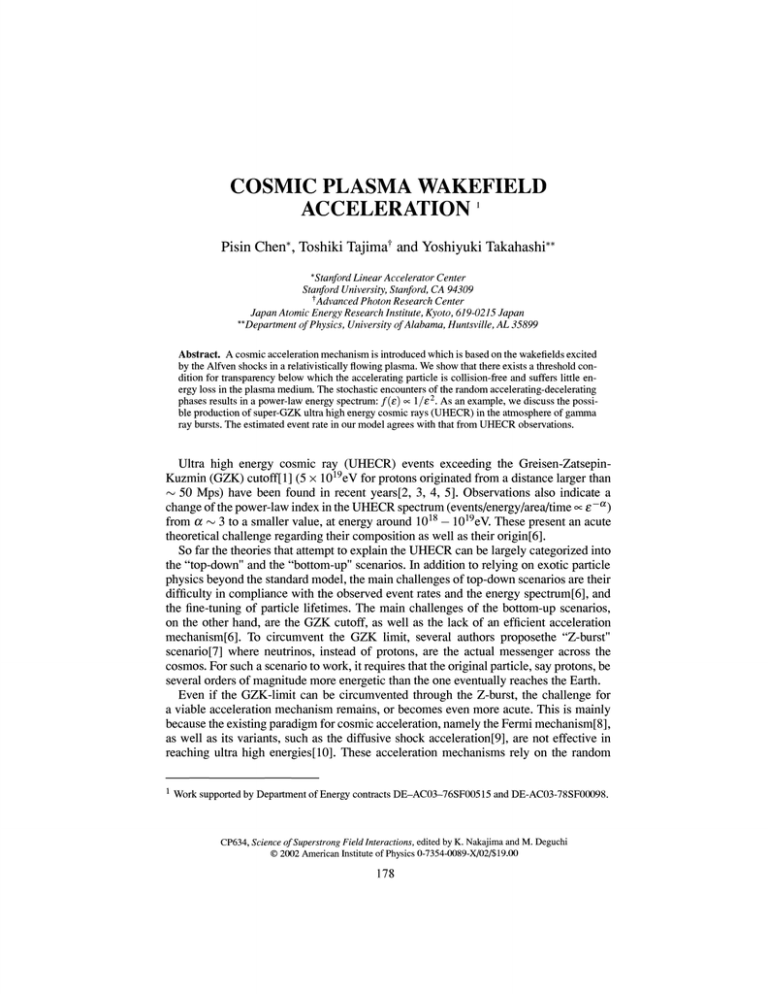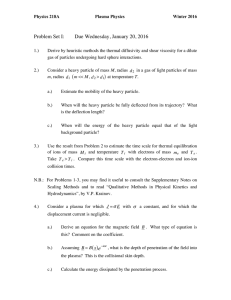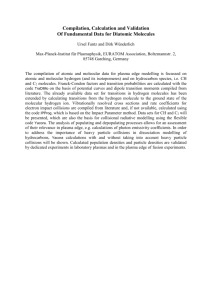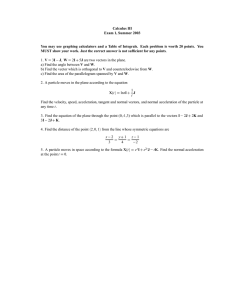COSMIC PLASMA WAKEFIELD ACCELERATION Pisin Chen*, Toshiki Tajima ^ and Yoshiyuki Takahashi**
advertisement

COSMIC PLASMA WAKEFIELD
ACCELERATION
Pisin Chen*, Toshiki Tajima1^ and Yoshiyuki Takahashi**
* Stanford Linear Accelerator Center
Stanford University, Stanford, CA 94309
^Advanced Photon Research Center
Japan Atomic Energy Research Institute, Kyoto, 619-0215 Japan
^Department of Physics, University of Alabama, Huntsville, AL 35899
Abstract. A cosmic acceleration mechanism is introduced which is based on the wakefields excited
by the Alfven shocks in a relativistically flowing plasma. We show that there exists a threshold condition for transparency below which the accelerating particle is collision-free and suffers little energy loss in the plasma medium. The stochastic encounters of the random accelerating-decelerating
phases results in a power-law energy spectrum: /(e) °c 1/e2. As an example, we discuss the possible production of super-GZK ultra high energy cosmic rays (UHECR) in the atmosphere of gamma
ray bursts. The estimated event rate in our model agrees with that from UHECR observations.
Ultra high energy cosmic ray (UHECR) events exceeding the Greisen-ZatsepinKuzmin (GZK) cutoff [1] (5 x 1019eV for protons originated from a distance larger than
~ 50 Mps) have been found in recent years[2, 3, 4, 5]. Observations also indicate a
change of the power-law index in the UHECR spectrum (events/energy/area/time ^ e~a)
from a ~ 3 to a smaller value, at energy around 1018 — 1019eV. These present an acute
theoretical challenge regarding their composition as well as their origin [6].
So far the theories that attempt to explain the UHECR can be largely categorized into
the "top-down" and the "bottom-up" scenarios. In addition to relying on exotic particle
physics beyond the standard model, the main challenges of top-down scenarios are their
difficulty in compliance with the observed event rates and the energy spectrum[6], and
the fine-tuning of particle lifetimes. The main challenges of the bottom-up scenarios,
on the other hand, are the GZK cutoff, as well as the lack of an efficient acceleration
mechanism[6]. To circumvent the GZK limit, several authors proposethe "Z-burst"
scenario[7] where neutrinos, instead of protons, are the actual messenger across the
cosmos. For such a scenario to work, it requires that the original particle, say protons, be
several orders of magnitude more energetic than the one eventually reaches the Earth.
Even if the GZK-limit can be circumvented through the Z-burst, the challenge for
a viable acceleration mechanism remains, or becomes even more acute. This is mainly
because the existing paradigm for cosmic acceleration, namely the Fermi mechanism[8],
as well as its variants, such as the diffusive shock acceleration[9], are not effective in
reaching ultra high energies [10]. These acceleration mechanisms rely on the random
1
Work supported by Department of Energy contracts DE-AC03-76SF00515 and DE-AC03-78SF00098.
CP634, Science of Super strong Field Interactions, edited by K. Nakajima and M. Deguchi
© 2002 American Institute of Physics 0-7354-0089-X/02/$ 19.00
178
collisions of the high energy particle against magnetic field domains or the shock media,
which necessarily induce increasingly more severe energy losses at higher particle
energies.
From the experience of terrestrial particle accelerators, we learn that it takes several
qualifications for an accelerator to operate effectively. First, the particle should gain energy through the interaction with the longitudinal electric field of a subluminous (v < c)
electromagnetic (EM) wave. In such a setting the accelerated particle can gain energy
from the field over a macroscopic distance, much like how a surfer gains momentum
from an ocean wave. It is important to note that such a longitudinal field is Lorentz
invariant, meaning that the acceleration gradient is independent of the instantaneous energy of the accelerating particle. Second, such a particle-field interaction should be a
non-collisional process. This would help to avoid severe energy loss through inelastic
scatterings. Third, to avoid excessive synchrotron radiation loss, which scales as particle energy squared, the accelerating particle should avoid any drastic bending beyond
certain energy regime. We believe that these qualifications for terrestrial accelerators are
also applicable to celestial ones.
Although they are still in the experimental stage, the "plasma wakefield accelerator"
concepts[l 1,12], promise to provide all the conditions stated above. Plasmas are capable
of supporting large amplitude electro-static waves with phase velocities near the speed
of light. Such collective waves, or "wakefields", can be excited by highly concentrated,
relativistic EM energies such as lasers[ll] and particle beams[12]. A trailing particle
can then gain energy by riding on this wakefield. Although hard scatterings between the
accelerating particle and the plasma medium is inevitable, under appropriate conditions,
as we will demonstrate below, the particle can be collision-free.
In this Letter we demonstrate that magneto-shocks (Alfven shocks) in a relativistic
plasma flow can also excite large amplitude plasma wakefields, which in turn can be
highly efficient in accelerating ultra high energy particles.
It is well-known that an ordinary Alfven wave propagating in a stationary magnetized
plasma has a velocity VA = eB0/(47tminp)l/2y which is typically much less than the speed
of light. Here Z?0 is the longitudinal magnetic field and np is the density of the magnetized
plasma. The relative strength between the transverse E and B fields of the Alfven wave is
EIE = v /c. Although the two components are not equal, being mutually perpendicular
to the direction of propagation they jointly generate a non-vanishing ponderomotive
force that can excite a wakefield in the plasma, which is slow: v h = VA <C c. For the
purpose of ultra high energy acceleration, such a wakefield would not be too useful, for
the accelerating particle can become quickly out of phase with the accelerating field.
In the case where the bulk flow of the plasma approaches the speed of light, however,
the Alfven waves acquire a phase velocity close to c and enhances the ratio of E/B to
~ Vp/c < 1, and it becomes indistinguishable from a bona fide EM wave. Preliminary
results from simulations indicate that such relativistic Alfven waves can indeed excite
plasma wakefields[13]. In this relativistic flow the excited wakefields are all in one
direction, which contributes to the unidirectional acceleration. With our applications to
astrophysical problems in mind, the Alfven-wave-plasma interaction relevant to us is in
the nonlinear regime.
179
The plasma wakefield in the nonlinear regime has been well-studied [14]. The nonlinearity is determined by the driving EM wave's ponderomotive potential, which is
governed by its normalized vector potential a0 = eE/mcco. When this parameter exceeds unity, nonlinearity is strong[l 1] so that additional important physics incurs. For a
stationary plasma, the maximum field amplitude that the plasma wakefield can support
is
meccop
£max ~ EwbaO = ————— aO '
(1)
which is enhanced by a factor a0 from the cold wavebreaking limit (the naively assumed
maximum field), Ewb = mec(Dp/e, of the linear regime. In a relativistic plasma flow
with a Lorentz factor Tp, the cold wavebreaking field is reduced by a factor rj/2 due to
Lorentz contraction. The maximum "acceleration gradient" G experienced by a singly charge particle riding on this plasma wakefield is then
(2)
The plasma wavelength, in the mean time, is stretched also by a factor a0 from that in
the linear regime. So in a plasma flow the wavelength is
where re = e2/mec2 = 2.8 x 10~13cm is the classical electron radius.
To determine the maximum possible energy gain, we need to know how far can a
test particle be accelerated. At ultra high energies once the test particle encounters a
hard scattering or bending, the hard-earned kinetic energy would most likely be lost.
The scattering of an ultra high energy proton with the background plasma is dominated
by the proton-proton collision. Existing laboratory measurements of the total pp cross
section scales roughly as opp = (T0 • (1+6.30 x 10~3[log(,s)]2-1}, where CTO « 32mb and
the center-of-mass energy-squared, s, is given in (GeV)2. In our system, even though the
UHE protons are in the ZeV regime, the center-of-mass energy of such a proton colliding
with a comoving background plasma proton is in the TeV range, so it is safe to ignore
the logarithmic dependence and assume a constant total cross section, app ~ (T0 ~ 30
mb in the ZeV energy regime. Since in astrophysical settings an out-bursting relativistic
plasma dilutes as it expands radially, its density scales as np(r) = n 0(/?0/r)2, where
n 0 is the plasma density at a reference radius RQ . The proton mean-free-path can be
determined by integrating the collision probability up to unity,
=
r*0
Yp
JR
r2
We find
(5)
180
Since Lmf is positive definite, 0 < [1 ~^o/(^o+^mfp)] < ^ Therefore the solution
to L , does not exist unless the coefficient, ^ppnp0R0/rp > 1. That is there exists a
threshold condition below which the system is collision-free:
Yp
When a system is below this threshold, a test particle can in principle be accelerated
unbound. In practice, of course, other secondary physical effects would eventually
intervene.
In a terrestrial accelerator, the wakefields are coherently excited by the driving beam,
and the accelerating particle would ride on the same wave crest over a macroscopic
distance. There the aim is to produce near-monoenergetic final energies (and tight phasespace) for high energy physics and other applications. In astrophysical settings, however,
the drivers, such as the Alfven shocks, will not be so organized. A test particle would
then face random encounters of accelerating and decelerating phases of the plasma
wakefields excited by Alfven shocks.
The stochastic process of the random acceleration-deceleration can be described by
the distribution function f ( s , t ) governed by the Chapman-Kolmogorov equation[15, 16]
If
Ul
= r°°d(Ae)W(e-Ae,Ae)f(e-Ae,t)
J — oo
- f+°°d(Ae)W (e, Ae)f(e, t) - v(e)f(e,t) .
(7)
J—— 00
The first term governs the probability per unit time of a particle "sinking" into energy
8 from an initial energy e — A£ while the second term that "leaking" out from e. The
last term governs the dissipation due to collision or radiation, or both. As we will
demonstrate later, the astrophysical environment that we invoke for the production of
UHECR is below the collision threshold condition, and so accelerating particles are
essentially collision-free.
The radiation loss in our system is also negligible. As discussed earlier, in a relativistic
flow the transverse E and B fields associated with the Alfven shock are near equal in
magnitude. Analogous to that in an ordinary EM wave, an ultra relativistic particle (with
a Lorentz factor y) co-moving with such a wave will experience a much suppressed
bending field, by a factor 1/y2. Furthermore, the plasma wakefield acceleration takes
place in the region that trails behind the shock (and not in the bulk of the shock) where
the accelerating particle in effect sees only the longitudinal electrostatic field colinear
to the particle motion [14]. We are therefore safe to ignore the radiation loss entirely as
well. We can thus ignore the dissipation term in the Chapman-Komogorov equation and
focus only on the purely random plasma wakefield acceleration-deceleration.
Assuming that the energy gain per phase encounter is much less than the final energy,
i.e., Ae <C £, we Taylor-expand W(e — Ae, Ae)/(e — Ae) around W(e, Ae)/(e) in the
sink term and reduce Eq.(9) to the Fokker-Planck equation
d
d
r+°°
d2
/"+00
dtf= del— ^ Ae ) Ae ^( £ > A£ )/( £ >0 + g^j^ ^(Ae)
181
Ae2
2
^(e,Ae)/(e,f). (8)
We now assume the following properties of the transition rate W(e, Ae) for a purely
stochastic process:
a) W is an even function;
b) W is independent of e;
c) W is independent of Ae.
Property a) follows from the fact that in a plasma wave there is an equal probability
of gaining and losing energy. In addition, since the wakefield amplitude is Lorentz
invariant, the chance of gaining a given amount of energy, Ae, is independent of the
particle energy e. Finally, under a purely stochastic white noise, the chance of gaining
or losing any amount of energy is the same. Based on these arguments we deduce that
where T is the typical time of interaction between the test particle and the random
waves and G is the maximum acceleration gradient (cf. Eq.(4)). We note that there is
a stark departure of the functional dependence of W in our theory from that in Fermi's
mechanism, in which the energy gain Ae per encounter scales linearly and quadratically
in e for the first-order and second-order Fermi mechanism, respectively.
To look for a stationary distribution, we put d f / d t = 0. Since W is an even function,
the first term on the RHS in Eq.(lO) vanishes. To ensure the positivity of particle energies
before and after each encounter, the integration limits are reduced from (—<*>, -h°°) to
[— e, -he], and we have
d2 r+e
__y
Ae2
d(Ae)—— W(e,Ae)/(e) = 0 .
(10)
Inserting W from Eq.(ll), we arrive at the energy distribution function that follows
power-law scaling,
/(e) = J ,
(ID
where the normalization factor e0 is taken to be the mean energy of the background
plasma proton, e0 ~ Ypmpc2. The actually observed UHECR spectrum is expected to be
degraded somewhat from the above idealized, theoretical power-law index, a = 2, not
only due to possible departure of the reality from the idealized model, but also due to
additional intermediate cascade processes that transcend the original UHE protons to the
observed UHECRs.
We note that a power-law energy spectrum is generic to all purely stochastic, collisionless acceleration processes. This is why both the first and the second order Fermi
mechanisms also predict power-law spectrum, if the energy losses, e.g., through inelastic
scattering and radiation (which are severe at ultra high energies), are ignored. The difference is that in the Fermi mechanism the stochasticity is due to random collisions of
the test particle against magnetic walls or the shock medium, which necessarily induce
reorientation of the momentum vector of the test particle after every diffusive encounter,
and therefore should trigger inevitable radiation loss at high energies. The stochasticity
in our mechanism is due instead to the random encounters of the test particle with different accelerating-decelerating phases. As we mentioned earlier, the phase vector of the
182
wakefields created by the Alfven shocks in the relativistic flow is nearly unidirectional.
The particle's momentum vector, therefore, never changes its direction but only magnitude, and is therefore radiation free in the energy regime that we consider for proton
acceleration.
We now apply our acceleration mechanism to the problem of UHECR. GRBs are by
far the most violent release of energy in the universe, second only to the big bang itself.
Within seconds (for short bursts) about £GRB ~ 1052erg of energy is released through
gamma rays with a spectrum that peaks around several hundred keV. Existing models for
GRB, such as the relativistic fireball model[17], typically assume neutron-star-neutronstar (NS-NS) coalescence as the progenitor. Neutron stars are known to be compact
(/?NS ~ (9(10)km) and carrying intense surface magnetic fields (BNS ~ 1012G). Several
generic properties are assumed when such compact objects collide. First, the collision
creates sequence of strong magneto-shocks (Alfven shocks). Second, the tremendous
release of energy creates a highly relativistic out-bursting fireball, most likely in the
form of a plasma.
The fact that the GRB prompt (photon) signals arrive within a brief time-window
implies that there must exists a threshold condition in the GRB atmosphere where the
plasma becomes optically transparent beyond some radius RQ from the NS-NS epicenter.
Applying Eq.(8) to the case of out-bursting GRB photons, this condition means
acn 0/?0
—^ = 1 ,
ip
(12)
where ac = (7tr^)(me/(DGRB)[log(2a)GRB/me) + 1/2] « 2 x 10~25cm2 is the Compton
scattering cross section. Since opp < (Jc, the UHECRs are also collision-free in the
same environment. There is clearly a large parameter space where this condition is
satisfied. To narrow down our further discussion, it is not unreasonable to assume
that R0 ~ (9(104)km. A set of self-consistent parameters can then be chosen: n 0 ~
1020cm-3,rp - 104, and e0 - 1013eV = e13.
To estimate the plasma wakefield acceleration gradient, we first derive the value for
the a0 parameter. We believe that the megneto-shocks constitute a substantial fraction,
say rfa ~ 10~2, of the total energy released from the GRB progenitor. The energy
Alfven shocks carry is therefore £A ~ 1050erg. Due to the pressure gradient along the
radial direction, the magnetic fields in Alfven shocks that propagate outward from the
epicenter will develop sharp discontinuities and be compactified[18]. The estimated
shock thickness is ~ (9(l)m at R0 ~ (9(104)km. From this and £A one can deduce the
magnetic field strength in the Alfven shocks at R0, which gives BA ~ 1010G. This leads
to a0 = eEA/mc(DA ~ 109. Under these assumptions, the acceleration gradient G (cf.
Eq.(4)) is as large as
Although the UHE protons can in principle be accelerated unbound in our system,
the ultimate maximum reachable energy is determined by the conservation of energy
183
and our assumption on the population of UHE protons. Since it is known that the
coupling between the ponderomotive potential of the EM wave and the plasma wakefield
is efficient, we assume that the Alfven shock energy is entirely loaded to the plasma
wakefields after propagating through the plasma. Furthermore, we assume that the
energy in the plasma wakefield is entirely reloaded to the UHE protons through the
stochastic process. Thus the highest possible UHE proton energy can be determined by
energy conservation
r£m
£
A ~ %HE ~ ^UHE /
Jel3
e/(e)de .
(14)
which gives
em = e13 exp(7]aeGRB/AfUHEe13) .
(15)
This provides a relationship between the maximum possible energy, ew, and the UHE
proton population, A^UHE. We assume that j]b ~ 10~2 of the GRB energy is consumed
to create the bulk plasma flow, i.e., T]&eGRB ~ NpTpmpc2 ~ Npel3, where Np is the
total number of plasma protons. We further assume that 7]c ~ 10~2 of the plasma
protons are trapped and accelerated to UHE, i.e., A^UHE ~ TlcNp. Then we find sm ~
e13 Qxp(rja/ribric). We note that this estimate of sm is exponentially sensitive to the ratio
of several efficiencies, and therefore should be handled with caution. If the values are
indeed as we have assumed, Tta/T/^TIc ~ <9(102), then em is effectively unbound until
additional limiting physics enters. Whereas if the ratio is ~ (9(10) instead, the UHE
cannot even reach the ZeV regime. The validity of our assumed GRB efficiencies then
relies on the consistency check against observations.
In addition to the energy production issue, equally important to a viable UHECR
model is the theoretical estimate of the UHECR event rates. The NS-NS coalescence rate
is believed to be about 10 events per day in the entire Universe[19, 20]. This frequency
is consistent with the observed GRB events, which is on the order of /GRB ~ 103'5 per
year.
In the Z-burst scenario an initial neutrino energy above 1021eV[7] or 1023eV[21]
is required (depending on the assumption of the neutrino mass) to reach the Z-boson
threshold. For the sake of discussion, we shall take the necessary neutrino energy as
ev > 1022eV. Such ultra high energy neutrinos can in principle be produced through the
collisions of UHE protons with the GRB background protons: pp -^7t+X —> /JL-\-v-\-X.
All UHE protons with energy £>22 > 1022eV should be able to produce such neutrinos.
The mean energy (by integrating over the distribution function /(e)) of these protons is
{£>22} ~ 0(100)e22. Therefore the multiplicity of neutrinos per UHE proton is around
jiL _ ^ , ~ 0(10) — 0(100). At the opposite end of the cosmic process, we also expect
multiple hadrons produced in a Z-burst. The average number of protons that Z-boson
produces is ~ 2.7[22]. Finally, the population of UHE protons above 1022eV is related
to the total UHE population by N>22 ~ (ei3/£22)^UHE ~ ^b^^GKR/^nPutting the above arguments together, we arrive at our theoretical estimate of the
expected UHECR event rate on earth,
JV
UHECR(> lo2°eV) = fwu^v^z^pp^-T-tf—
184
GRB
d6)
GRB
The typical observed GRB events is at a redshift z ~ 0(1), or a distance /?GRB ~ 1022km.
Our estimate of observable UHECR event rate is therefore
^UHECR(> lo2°eV) = O(l)/100km2/yr/sr ,
(17)
which is consistent with observations, or in turn this observed event rate can serve as a
constraint on the various assumptions of our specific GRB model.
We have demonstrated that plasma wakefields excited by Alfven shocks in a relativistic plasma flow can be a very efficient mechanism for cosmic acceleration, with a
power-law energy spectrum. When invoking GRBs as the sites for UHECR production
with a set of reasonable assumptions, we show that our estimated UHECR event rate is
consistent with observations. This cosmic acceleration mechanism is generic, and can in
principle be applied to other astrophysical phenomena, such as blazars[23]. It is generally believed that the AGN jets are relativistic plasmas. The observed "lumps", or density
concentrations, in the jet may well serve as the driver to excite plasma wakefields. These
wakefields can accelerate electrons as well as protons to multi-TeV energies. Bent by the
confining helical magnetic fields in the jet, these high energy electrons can radiate hard
photons in the TeV range, while the protons can cascade into high energy neutrinos. We
will present a more detailed discussion on blazars in a separate paper.
We appreciate helpful discussions with J. Arons, R. Blandford, P. Meszaros.
REFERENCES
1.
2.
3.
4.
5.
6.
7.
8.
9.
10.
11.
12.
13.
14.
15.
16.
K. Greisen, Phys. Rev. Lett. 16,748 (1966); G. T. Zatsepin and V. A. Kuzmin, Pis'maZh. Eksp. Teor.
Fiz. 4, 114 (1966) [JETP Lett. 4,78 (1966)].
D. J. Bird et al., Phys. Rev. Lett. 71, 3401 (1993); Astrophys. J. 424, 491 (1994); 441, 144 (1995).
M. Takeda et al., Phys. Rev. Lett. 81,1163 (1998); Astrophys. J. 522, 225 (1999).
T. Abu-Zayyad et al., Int. Cosmic Ray Conf. 3, 264 (1999).
M. A. Lawrence, R. J. O. Reid, and A. A. Watson, J. Phys. G Nucl. Part. Phys. 17, 773 (1991).
A. V. Olinto, Phys. Rep. 333-334, 329 (2000).
T. Weiler, Astropart. Phys. 11, 303 (1999); D. Fargion, B. Mele, and A. Salis, Astrophys. J. 517, 725
(1999).
E. Fermi, Phys. Rev. 75, 1169 (1949); Astrophys. J. 119, 1 (1954).
W. I. Axford, E. Leer, and G. Skadron, in Proc. 15th Int. Cosmic Ray Conf. (Plovdic) 11,132 (1977);
G. F. Krymsky, Dokl. Acad. Nauk. SSR 234,1306 (1977); A. R. Bell, Mon. Not. R. Astro. Soc. 182,
147 (1978); R. D. Blandford and J. F. Ostriker, Astrophys. J. Lett. 221, L29 (1978).
A. Achterberg, in Highly Energetic Physical Processes and Mechanisms for Emission from Astrophysical Plasmas, IAU Symposium, vol. 195, P. C. H. Martens and S. Tsuruta, eds. (1999).
T. Tajima and J. M. Dawson, Phys. Rev. Lett. 43, 267 (1979).
P. Chen, J. M. Dawson, R. Huff, and T. Katsouleas, Phys. Rev. Lett. 54, 693 (1985).
P. Romenesko, P. Chen, T. Tajima, in preparation (2002).
E. Esarey, P. Sprangle, J. Krall, and A. Ting, IEEE Trans. Plasma Sci. 24, 252 (1996).
K. Mima, W. Horton, T. Tajima, and A. Hasegawa, in Proc. Nonlinear Dynamics and Particle
Acceleration, eds. Y.H.Ichikawa and T.Tajima (AIP, New York, 1991) p.27.
Y. Takahashi, L. Hillman, T. Tajima, in High Field Science, eds. T. Tajima, K. Mima, H. Baldis,
(Kluwer Academic/Plenum 2000) p. 171.
185
17. M. J. Rees and P. Meszaros, Mon. Not. R. Astro. Soc. 158, P41 (1992); P. Mezsaros and M. J. Rees,
Astrophys. J. 405, 278 (1993).
18. A. Jeffrey and T. Taniuti, Nonlinear Wave Propagation, (Academic Press, NY, 1964).
19. T. Piran, ApJ Letters 389, L45 (1992); A. Shemi and T. Piran, Atrophys. J. 365, L55 (1990).
20. LISA collaboration, http://www.lisa.uni-hannover.de/
21. G. Gelmini and G. Varieschi, UCLA/02/TEP/4 (2002), unpublished.
22. Particle Data Group, Phys. Rev. D54, 187 (1996).
23. M. Punch et al., Nature 358, 477 (1992); J. Quinn et al., ApJ Letters 456, L63 (1996); C. M. Urry,
Advances in Space Research 21, 89 (1998).
186





